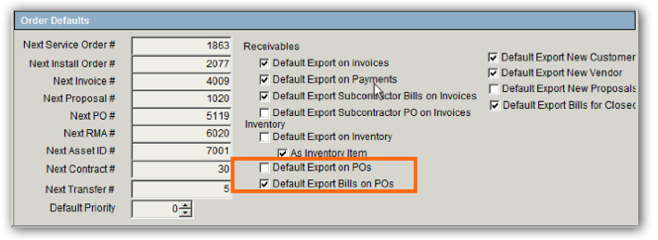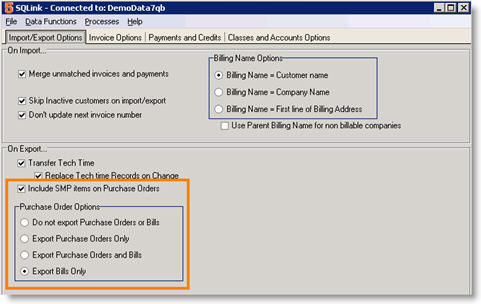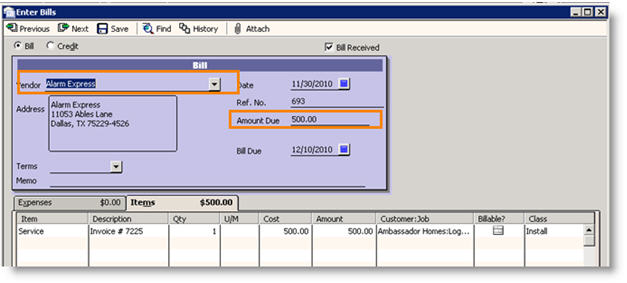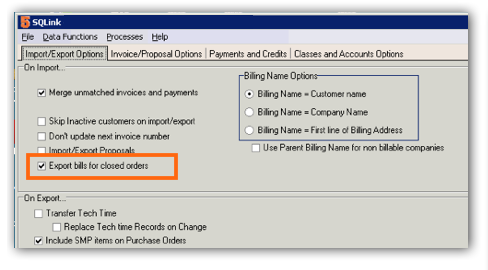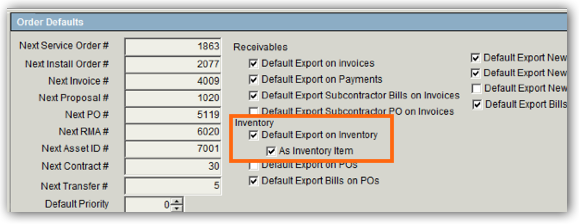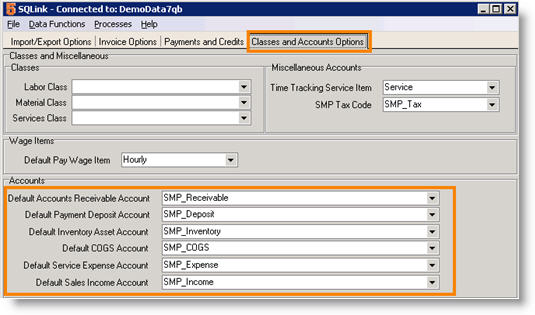Difference between revisions of "Default Export to QuickBooks Settings"
(Fixed video player) |
|||
| (4 intermediate revisions by 2 users not shown) | |||
| Line 16: | Line 16: | ||
'''Don't default Tech Timesheet Export''' - If left unchecked then labor items will automatically be set to sync to a timesheet entry in QB. If checked, you can create the labor on orders and once you check the "Export Timesheet to QB" checkbox on the labor, then the labor will sync to QB timesheet. | '''Don't default Tech Timesheet Export''' - If left unchecked then labor items will automatically be set to sync to a timesheet entry in QB. If checked, you can create the labor on orders and once you check the "Export Timesheet to QB" checkbox on the labor, then the labor will sync to QB timesheet. | ||
| − | '''Tax Premium, Trip, Freight and Other Charges''' - Check these boxes if you want to charge taxes on premium labor, trip charge, | + | '''Tax Premium, Trip, Freight and Other Charges''' - Check these boxes if you want to charge taxes on premium labor, trip charge, freight charge and other charges. These fields are on the Totals tab of a service order (image below). Please visit the '''[[SMP Items]]''' page to read about setting up SMP_Premium, SMP_Travel, SMP_Freight, and SMP_Misc in QuickBooks. |
<br>[[File:PremiumTripOtherFrightFields.png]] | <br>[[File:PremiumTripOtherFrightFields.png]] | ||
== Export Options for Purchase Orders == | == Export Options for Purchase Orders == | ||
| − | + | {{#ev:youtube| 9K5J9KmqIUs }} | |
Check one of the next two options for how SME exports purchase orders to QuickBooks: | Check one of the next two options for how SME exports purchase orders to QuickBooks: | ||
| Line 94: | Line 94: | ||
Inventory is managed in one of two ways when SME is syncing with QuickBooks: | Inventory is managed in one of two ways when SME is syncing with QuickBooks: | ||
| − | <br>· '''As SME Only Inventory''' – | + | <br>· '''As SME Only Inventory''' – Go to the '''[[GL Entries for SME Inventory]]''' page to review the settings required to maintain inventory in SME only. |
| − | |||
<br>· '''As SME and QuickBooks Inventory''' – inventory items are synced and are maintained in both applications. Invoicing for material in SME decreases stock in QuickBooks. Creating Purchase Orders for material in SME increase stock in QuickBooks. Manually changing stock numbers will have to be done in both SME using [[Inventory Quantity Reconciliation]] and also in QuickBooks. | <br>· '''As SME and QuickBooks Inventory''' – inventory items are synced and are maintained in both applications. Invoicing for material in SME decreases stock in QuickBooks. Creating Purchase Orders for material in SME increase stock in QuickBooks. Manually changing stock numbers will have to be done in both SME using [[Inventory Quantity Reconciliation]] and also in QuickBooks. | ||
| Line 108: | Line 107: | ||
<br>[[File:InventoryItemFields SyncToQB.png]] | <br>[[File:InventoryItemFields SyncToQB.png]] | ||
| − | Individual inventory items can be setup | + | Individual inventory items can be setup with accounts other than those set as defaults in SQLink. |
<br>1. Open SME. | <br>1. Open SME. | ||
<br>2. Go to the '''Inventory''' module > '''Inventory'''. | <br>2. Go to the '''Inventory''' module > '''Inventory'''. | ||
Latest revision as of 17:45, 4 March 2022
If you are syncing SME with QuickBooks, choose which forms in SME export to QuickBooks by default.
Default Export on Invoices – If checked, new invoices in SME will export to QuickBooks. This option is usually checked.
Default Export on Payments – If checked, payment entered in SME will export to QuickBooks. This option is usually checked.
Default Export New Customer - If checked, new customers entered in SME will export to QuickBooks. This option is usually checked.
Default Export New Vendor - If checked, new vendors entered in SME will export to QuickBooks. This options is usually checked.
Default Export New Proposals - If checked, new proposals entered in SME will export to QuickBooks as an estimate.
Don't default Tech Timesheet Export - If left unchecked then labor items will automatically be set to sync to a timesheet entry in QB. If checked, you can create the labor on orders and once you check the "Export Timesheet to QB" checkbox on the labor, then the labor will sync to QB timesheet.
Tax Premium, Trip, Freight and Other Charges - Check these boxes if you want to charge taxes on premium labor, trip charge, freight charge and other charges. These fields are on the Totals tab of a service order (image below). Please visit the SMP Items page to read about setting up SMP_Premium, SMP_Travel, SMP_Freight, and SMP_Misc in QuickBooks.
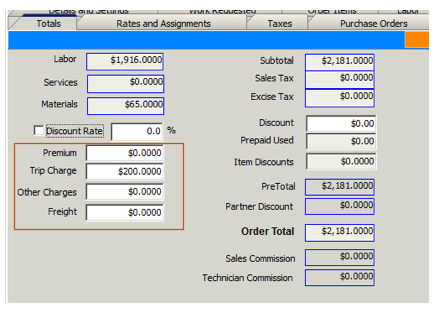
Export Options for Purchase Orders
Check one of the next two options for how SME exports purchase orders to QuickBooks:
Default Export for New POs – If checked, purchase orders created in SME will export to QuickBooks as a purchase order.
-OR-
Default Export Bills for New POs – If checked, when material is received on POs in SME, SME will export a bill to QuickBooks what you owe the vendor for the part received. If the inventory item on the bill is in QuickBooks, the bill will increase the stock in QB. This option is more common than exporting POs.
Related SQLink Setup
1. Open SQLink.
2. Click File > Setup.
3. Click Edit at the bottom.
4. Check Include SMP Items on Purchase Order. If the inventory item on the purchase order is not in QuickBooks, then it uses the SMP Item.
5. Locate the Purchase Orders Options section.
6. If you checked Default Export For New Purchase Orders in SME, make sure you have Export Purchase Orders Only in SQLink.
7. If you checked Default Export Bills for New Purchase Order in SME, make sure you have Export Bills Only in SQLink.
8. Export Purchase Orders & Bills – check here if you chose to default purchase orders and bills for SME purchase orders. This is uncommon.
9. Click Save at the bottom.
NOTE- If you put an inventory item on a PO and change the description on the PO Item, the PO Item description will transfer to the QB Bill instead of the Inventory Item description.
Export Options for Subcontractors
When you add a service item to an order and add a subcontractor to the service, SME can either export a bill for the subcontractor in QuickBooks for the cost of the service item, or export a PO in QuickBooks for the subcontractor.
Choose one of the following three options :
1 - Send Bill for Subcontractor Cost when you invoice the order
- In SME, check Default Export Subcontractor Bills on Invoice.
- In SQLink, click File > Setup > Invoice/Proposal Options tab, check Export Bills for Subcontractor
When the order is invoiced and the invoice is synced to QuickBooks, the bill is generated in QuickBooks. A bill will also be generated if you create a new itemized invoice in SME, a bill will be generated in QuickBooks. (image below)
2 - Send PO for Subcontractor Cost when you invoice the order
- In SME, check Default Export Subcontractor POs on Invoice.
- In SQLink, click File > Setup > Invoice/Proposal Options tab, check Export Purchase Orders for Subcontractor
This option is used by companies that have subcontractors on many service orders. Rather than generating separate bills for every order, they export purchase orders to QuickBooks. In QuickBooks, they can then add the purchase orders to one bill to pay subcontractor. The PO will be generated when you sync the invoice for the service order to QuickBooks.
3 - Send Bill for Subcontractor Cost when you close the order
If you prefer to send the subcontractor bill to QuickBooks when you close the order instead of sending over with the invoice, then make sure you check the following:
- In SME, Setup module > Order, check Default Export Bills for Closed
- In SQLink, click File > Setup, check Export Bills for Closed Orders (circled in image below on the left)
The date on the bill comes from the Opened Date on the order in SME.
Subcontractors on Labor Items
If you don't add subcontractors to service items, but instead you schedule your subcontractors using the Labor Editor/Dispatch, you can still send Bills or POs for their cost. Make sure you do the following setup in SQLink.
1. Open SQLink.
2. Click File > Setup
3. Click the Invoice/Proposal Options tab.
4. Click Edit at the bottom
5. Check Include Labor Records on Subcontractor Bills and POs
6. Click Save.
Export Options for Inventory Items
Inventory is managed in one of two ways when SME is syncing with QuickBooks:
· As SME Only Inventory – Go to the GL Entries for SME Inventory page to review the settings required to maintain inventory in SME only.
· As SME and QuickBooks Inventory – inventory items are synced and are maintained in both applications. Invoicing for material in SME decreases stock in QuickBooks. Creating Purchase Orders for material in SME increase stock in QuickBooks. Manually changing stock numbers will have to be done in both SME using Inventory Quantity Reconciliation and also in QuickBooks.
Default Export for New Inventory – Check here if you are tracking inventory items in SME and QuickBooks. New Inventory items added in SME will be exported to QuickBooks.
As Inventory Item – Check here if you chose to export new inventory items to QuickBooks. If not checked, the item will export to QuickBooks as a non-inventory item.
The image below shows how the inventory item name and description fields sync to QuickBooks.

Individual inventory items can be setup with accounts other than those set as defaults in SQLink.
1. Open SME.
2. Go to the Inventory module > Inventory.
3. Click Search to find the inventory item.
4. Click the Link Options tab
5.Select the Cost of Goods Account, Inventory Asset Account, and Income Account you want this inventory item to sync to in QuickBooks with.
6. Click Save.
Related SQLink Setup
If you checked Default Export for New Inventory, the default inventory Cost of Goods, Inventory Asset, and Sales Income accounts in SQLink are used as the defaults for any new inventory items entered in SME. (circled in image below)
You can choose accounts for individual inventory items on the Link Options tab as shown on the image above.
If you want to change the defaults, you can follow the steps below.
1. Open SQLink.
2. Click File > Setup.
3. Click the Classes and Accounts Options tab.
4. Click Edit at the bottom.
5. Locate the Accounts section. (circled above)
6. Select the following accounts you want inventory to be the default accounts for items exporting to QuickBooks:
- Default Inventory Asset Account
- Default COGS Account
- Default Sales Income Account
7. Click Save.

